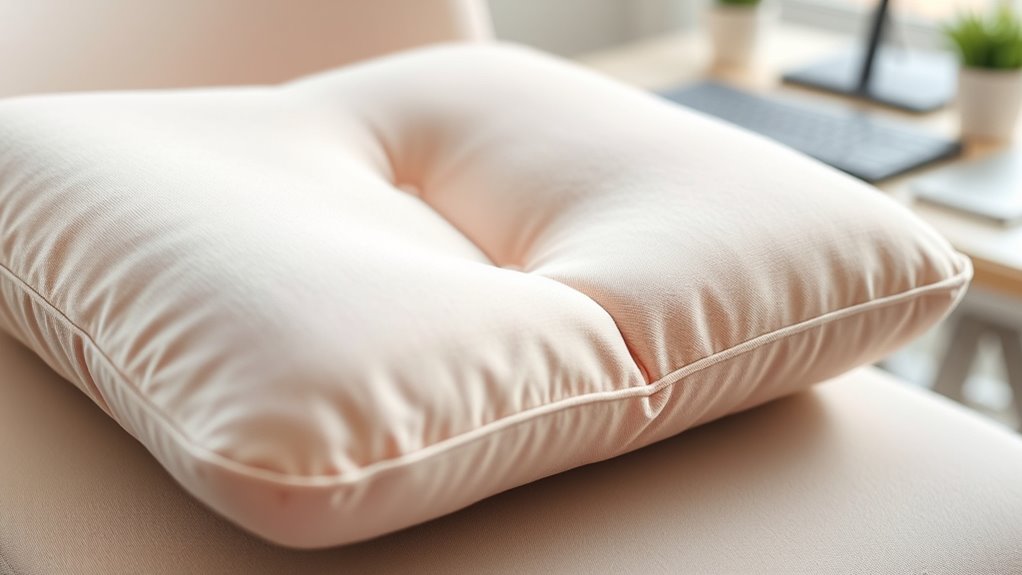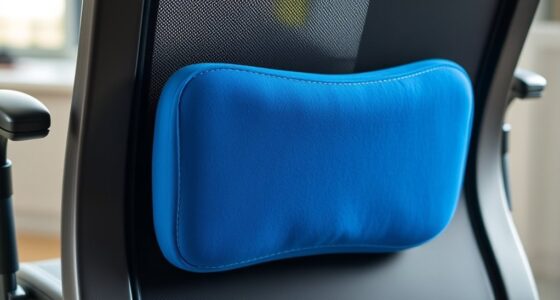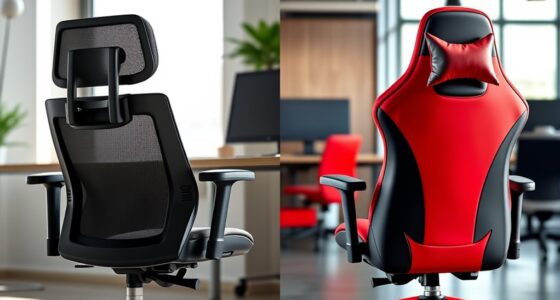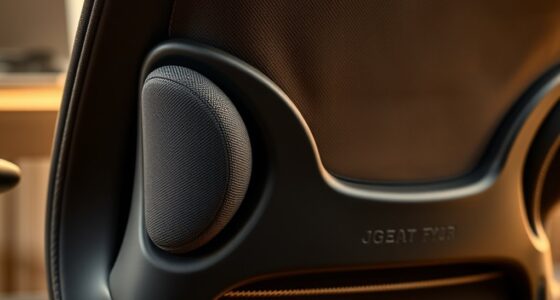To relieve tailbone pain easily, try using an ergonomic cushion designed to support your natural curves and distribute pressure evenly. Place it on your chair to keep your pelvis and lower back aligned, preventing slouching and discomfort. Look for features like memory foam or gel padding with cutouts for extra coccyx relief. Combining these simple hacks can make a big difference in your sitting comfort—discover more ways to improve support and posture here.
Key Takeaways
- Position the cushion correctly on your chair to support your lower back and evenly distribute pressure.
- Use cushions with memory foam or gel padding for better contouring and pressure relief.
- Incorporate cutouts or beveled edges to specifically target coccyx relief and reduce tailbone pressure.
- Adjust the cushion’s placement throughout the day to prevent discomfort from prolonged sitting.
- Combine the cushion with good posture habits and take regular breaks to enhance tailbone pain relief.
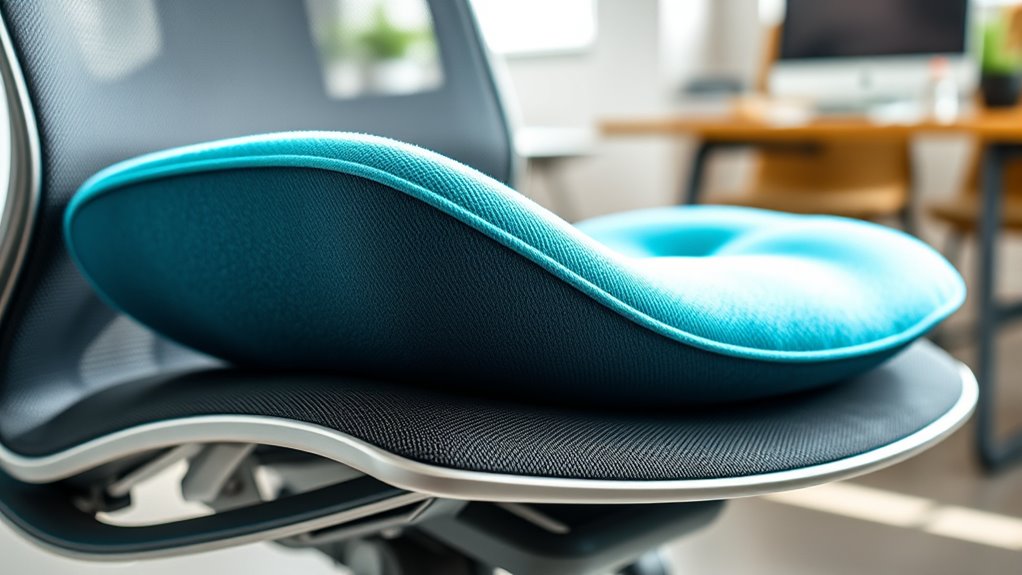
A comfortable chair cushion can make a big difference in your daily sitting experience, whether you’re working at a desk or relaxing at home. If you often find yourself battling tailbone pain or discomfort after hours of sitting, upgrading to the right cushion can be a game-changer. One of the key factors to look for is an ergonomic design. An ergonomically shaped cushion supports your natural body contours, helping to distribute your weight evenly and reduce pressure on your coccyx. This design encourages better posture, which not only alleviates tailbone pain but also prevents long-term issues caused by poor sitting habits.
An ergonomic cushion supports your body, relieves tailbone pain, and promotes better posture for everyday comfort.
When choosing a chair cushion, consider portable solutions that fit seamlessly into your busy lifestyle. Many ergonomic cushions are lightweight and easy to carry, making them perfect for use at the office, in your car, or even on planes. Portable solutions allow you to take comfort with you wherever you go, ensuring you don’t have to suffer through discomfort in different settings. They’re often designed with durable, easy-to-clean covers, so maintenance is simple, and you can keep your cushion looking fresh and inviting.
Proper positioning is vital when using a cushion to relieve tailbone pain. Place the cushion on your chair so that it supports your lower back and pelvis, encouraging a more upright and natural sitting posture. Avoid slouching or leaning too far back, as these habits can exacerbate coccyx pressure. When your cushion is well-positioned, it acts as a buffer between your tailbone and the hard surface of your chair, helping to absorb shocks and reduce strain.
In addition to ergonomic design and portability, look for features like memory foam or gel-infused padding, which conform to your body shape and provide extra comfort. These materials help disperse pressure points, which is essential for tailbone relief. Some cushions also come with cutouts or beveled edges specifically designed to alleviate coccyx pressure, making them even more effective. Incorporating well-designed cushions can also be part of a broader strategy to promote better posture and overall spinal health.
Ultimately, selecting a cushion that combines ergonomic principles with portable solutions can considerably improve your sitting comfort and ease tailbone pain. By investing in the right support, you make your daily routines more comfortable and protect yourself from long-term discomfort. Remember, the right cushion isn’t just an accessory—it’s a practical tool for healthier sitting habits, whether you’re at work, traveling, or relaxing at home.
Frequently Asked Questions
Can Chair Cushions Cause Allergies or Skin Irritation?
You might wonder if chair cushions can cause allergies or skin irritation. If you have chemical sensitivities, it’s possible. Look for cushions made with hypoallergenic fabrics to reduce risks. Some materials may contain dyes or chemicals that trigger reactions. Always check product labels and choose cushions designed for sensitive skin. This way, you can enjoy comfort without worrying about allergies or irritation caused by unsuitable materials.
Are There Specific Materials Best for Long-Term Comfort?
Did you know that poor seating can cause long-term discomfort? For lasting comfort, you should choose cushions made of memory foam or gel-filled materials. Memory foam molds to your body, providing personalized support and reducing pressure points, while gel-filled cushions offer cool, even support that stays comfortable over time. Both are excellent options for maintaining comfort and preventing tailbone pain during extended sitting sessions.
How Often Should I Replace My Chair Cushion?
You should replace your chair cushion when it shows signs of wear, like persistent sagging, loss of support, or discomfort. Follow a regular replacement schedule, typically every 6 to 12 months, depending on usage. To keep it comfortable longer, clean your cushion regularly and inspect it for deterioration. If cleaning no longer restores comfort or support, it’s time for a new one to prevent tailbone pain and maintain proper posture.
Can Cushion Hacks Improve Posture or Only Relieve Pain?
Like a steady hand guiding a ship, cushion hacks can improve your posture and provide long-term benefits. While they mainly relieve pain, certain tricks support correct alignment, making your sitting position more ergonomic. Regularly using these hacks encourages posture correction over time, helping prevent future discomfort. So, yes, cushion hacks can do more than ease pain—they can actively promote better posture and contribute to your overall musculoskeletal health.
Are There Any Safety Concerns With Homemade Cushion Solutions?
When considering DIY foam cushions, safety is key. You should be cautious with homemade solutions, especially regarding cushion chemicals used in some DIY foam projects. Always make certain of proper ventilation and avoid toxic adhesives or dyes. While DIY foam can be effective, it’s crucial to research and choose non-toxic, safe materials to prevent skin irritation or health issues. Prioritize safety to enjoy comfort without risking harm.
Conclusion
By exploring these chair cushion hacks, you’re gently guiding yourself toward a more comfortable, balanced day. Sometimes, a subtle change can make all the difference, helping you sit with a little more ease and grace. Remember, small adjustments can softly reshape your experience, easing the subtle burdens that often go unnoticed. Embrace these simple tips, and let them quietly support your journey toward greater comfort and well-being.
